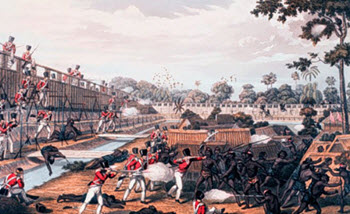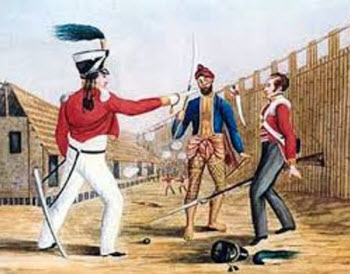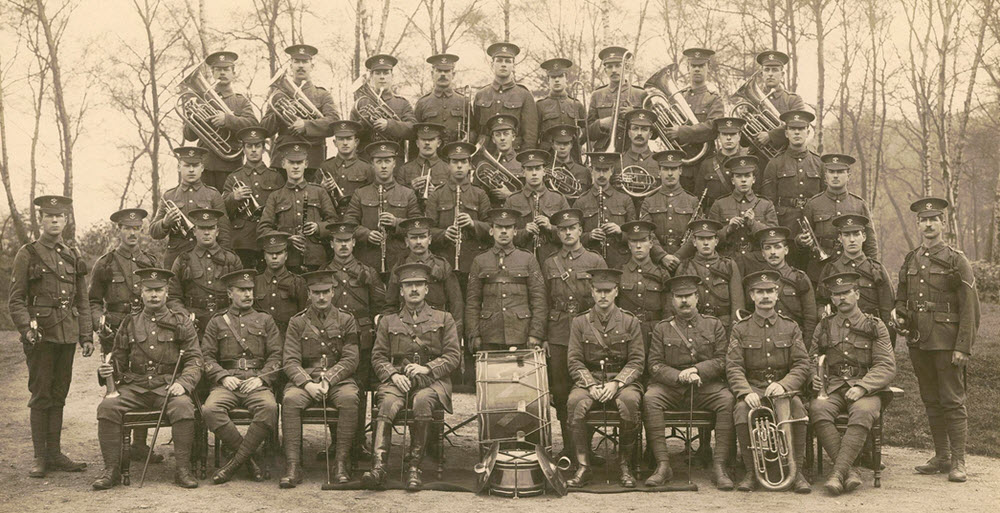Contents
The Somerset Light Infantry (Prince Albert’s) was a light infantry regiment of the British Army, which served under various titles from 1685 to 1959. In the 19th century, the regiment was deployed to many different parts of Asia and Africa to protect British interests.
On this page, you will find information about the regiment’s participation in the Anglo-Burmese War of 1824 – 1826 and the First Anglo-Afghan War.
The Anglo-Burmese War
 In September 1822, the 13th (1st Somersetshire) Regiment of Foot was sent to Chathmam in Kent, England to be brought up to strength. The British Empire needed the regiment in India. While in Kent, the regiment was given a new name: 13th (1st Somersetshire) Regiment (Light Infantry).
In September 1822, the 13th (1st Somersetshire) Regiment of Foot was sent to Chathmam in Kent, England to be brought up to strength. The British Empire needed the regiment in India. While in Kent, the regiment was given a new name: 13th (1st Somersetshire) Regiment (Light Infantry).
The following year, the 13th (1st Somersetshire) Regiment (Light Infantry) left for India and arrived in Calcutta (Kolkata) in May and June 1823. In March 1824, war with Burma was formally declared, after Burmese forces attacked Cachar, a territory under British protection. The 13th Light Infantry participated in the campaign, until a peace treaty was signed in early 1826. After the Anglo-Burmese War, the 13th Light Infantry went back to India were they would remain until 1838. During this period, they were station in Baharampur , Danapur, Agra and Karnal.
The First Anglo-Afghan War
 In November 1838, the 13th Light Infantry joined the newly formed Army of the Indus and reached Afghanistan in March 1839, taking Kandahar in April. The reason behind the British invasion was a fear of Russian intervention in the region. In 1837 Persian troops were occupying Afghanistan’s Herat area, and they were strongly allied with Russia. As a response, the British decided to remove the emir of Afghanistan – a man named Dost Muhammad – and replace him with Shuja Shah Durrani, who they hoped would protect British interests over Russian. To this aim, the Army of the Indus was assembled and sent into Afghanistan.
In November 1838, the 13th Light Infantry joined the newly formed Army of the Indus and reached Afghanistan in March 1839, taking Kandahar in April. The reason behind the British invasion was a fear of Russian intervention in the region. In 1837 Persian troops were occupying Afghanistan’s Herat area, and they were strongly allied with Russia. As a response, the British decided to remove the emir of Afghanistan – a man named Dost Muhammad – and replace him with Shuja Shah Durrani, who they hoped would protect British interests over Russian. To this aim, the Army of the Indus was assembled and sent into Afghanistan.
Once Kandahar had been taken by the Army of the Indus, the next major battle for the 13th Light Infantry was in Ghazni in July. After succeeding in Ghazni, the British enthroned Shuja Shah Durrani the following month. To enforce the rule of the new monarch, a British occupation force remain in Afghanistan and the 13th Light Infantry was a part of this force.
Uprising and siege
In October 1841, Shuja was overthrown in a popular uprising that managed to take Kabul, the capital of Afghanistan. The 13th Light Infantry initially fought the uprising, but was forced to retreat to the town of Jellalabad (Jalalabad) in November.
Jellalabad, which was a fortified city, was soon besieged by anti-British Afghan forces. It would take until April 1842 before the British garrison, led by Sir Robert Sale of the 13th Light Infantry, managed to break the siege and defeat Akbar Khan’s men.
Peace and royal patronage
 The Anglo-Afghan War ended in October 1842 and the Army of the Indus, including the 13th Light Infantry, went back to India. To honour the 13th Light Infantry’s achievements in Jellalabad, a 21 gun salute was fired at each army station the regiment passed on its way back.
The Anglo-Afghan War ended in October 1842 and the Army of the Indus, including the 13th Light Infantry, went back to India. To honour the 13th Light Infantry’s achievements in Jellalabad, a 21 gun salute was fired at each army station the regiment passed on its way back.
The conduct of the 13th Light Infantry in Jellalabad was also rewarded by Prince Albert, who became the regiment’s official patron and allowed the use of his name in the regiment’s title. The regiment thus became the 13th (1st Somersetshire) (Prince Albert’s Light Infantry) Regiment of Foot. This royal patronage also meant that the traditional yellow facings of the regiment uniform was changed to a royal blue colour. To commemorate the regiment’s valour in Afghanistan, they were given a badge sporting a mural crown with a scroll inscribed “Jellalabad” to be displayed on the colours and uniform of the regiment.
After the end of the Anglo-Afghan War in 1842, the 13th (1st Somersetshire) (Prince Albert’s Light Infantry) Regiment of Foot remained in India until 1845 when they returned to England. The regiment had first arrived in India in 1823 and thus spent well over two decades in foreign service. Back home in Britain, they were presented with new colours at Portsmouth in 1846, before being sent to Ireland in 1847. In 1850 they left Ireland for a year in Scotland, before making the journey south to Gibraltar were the regiment remained until 1854.

